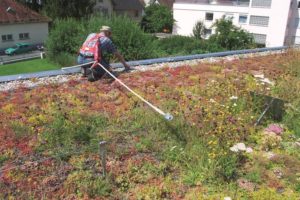
Nick Day, Managing Director at Optigreen Ltd answers some of their customer’s most frequent questions…
The increase in the number of green roof specifications over the last few years has led to more people, be they architects, builders or roofing contractors being exposed to a new and unfamiliar technology which is roof greening.
There is a requirement for an “extensive” green roof, what does that mean?
An extensive green roof has a relatively shallow depth build-up, is not usually irrigated and has a low maintenance requirement. Vegetation would typically be drought tolerant plants such as sedums, mosses and wildflowers. Another term that is sometimes used is a “biodiverse” roof. This is still essentially an extensive roof but will have been designed to create a specific habitat for plants, insects and birds. Neither of these types of roof are designed to be accessible apart from for maintenance purposes.
What is a Blue Roof?
A Blue Roof is a flat roof designed to allow controlled attenuation of rainfall during an intense or storm event as part of a Sustainable Urban Drainage Systems Policy (SuDS) policy. A Blue Roof can be created at roof level or on a podium and will be designed to store water temporarily and release it from the building at a controlled and managed rate, usually over a period of 12 -24 hours after the rainfall event. The build-up will normally consist of a storage or void board working (rather than a drainage board) with adjustable or controlled outlets with a green roof surface or alternatively paving or pebble finish.
Does my green roof need a separate root barrier?
The easiest way to achieve root protection is to use a suitable root resistant waterproofing membrane. The minimum requirement is that the waterproofing membrane should be certified to FLL guidelines* in terms of root resistance and/or should have BBA certification as being suitable for use in a green roof application. If the project is new build this requirement can normally be accommodated within the waterproofing specification. If the green roof is being retrofitted and the existing waterproofing is not being replaced a separate root barrier layer should always be used.
Can green roofs be laid at zero-degree falls?
Where a green roof is required on a roof with zero-degree falls, provision should be made within the green roof specification to cater for ponding water that may occur because of back falls or a build-up of waterproofing layers around outlets. This can be achieved using a suitable profiled drainage board in conjunction with a filter mat to create separation between the ponding water and substrate layer. A space should always be maintained between the maximum level of ponding water and the filter mat to avoid any capillary action and subsequent waterlogging at the base of the substrate layer. Optigreen’s standard 25mm depth drainage board for example can accommodate a maximum ponding water depth of 15mm.
This is generally more of a concern with warm or cold roof construction as on inverted roofs the waterproofing layer is separated from the green roof by the insulation board.
Can a green roof be installed on a pitched roof?
Yes, it can but specific measures are required usually above 10-15 degrees pitch to counter shear forces and potential slippage of the green roof build-up. Also, the roof specification needs to consider the requirement to store sufficient water particularly on steeper pitches. Project specific advice should be sought from a green roof manufacturer as requirements will vary depending on factors such as roof pitch, configuration, slope length etc. The maximum roof pitch that a green roof can be installed on will depend on the systems that the individual manufacturer has available. At Optigreen, for example, we can cater for roofs of up to 45 degrees pitch.
Does a green roof require irrigation?
This will depend on the type of green roof. Most extensive roofs will not require irrigation beyond the first 6-8 weeks after installation if a good quality drainage/reservoir board has been used alongside the correct depth of engineered substrate. Most intensive roofs will need irrigation as vegetation on these roofs will typically be, for example, shrubs, trees and lawns.
Can you put a green roof on an existing building?
You can but it’s important to consider the weight of the green roof and the capacity of the existing roof structure to accept the load. We generally refer to saturated system weights, i.e. the weight when the build -up is at maximum water storage capacity. A typical extensive sedum roof, for example, will have a saturated weight of approximately 100kg/m2 with a biodiverse wildflower roof weighing considerably more. Some manufacturers like ourselves have developed special lightweight solutions which can overcome the issue of inadequate structural capacity.
What level of maintenance do green roofs require?
All green roofs will require regular maintenance to maintain their health and appearance. A typical extensive roof will need a minimum of two visit per year, usually in Spring and Autumn. The maintenance schedule will normally include weeding, keeping vegetation margins clear and, once a year, the application of a slow release fertiliser. An intensive roof with lawns or deep planters will usually require the same level of maintenance as a typical garden would and this will depend on the planting specification.
There is a wealth of independent technical information on green roofs available from The Green Roof Organisation (GRO) in the GRO Green Roof Code 2014. This has been developed as a code of best practice for roof greening in the UK. A copy of this can be downloaded at www.greenroofcode.co.uk

